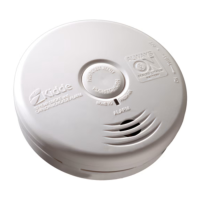OPTION 2:
Mounting on Other Surfaces
1. Choose a mounting location (wall or
ceiling) and using the mounting plate
provided as a template, mark three-
hole locations.
2. Install the three provided screws
through the mounting plate and tighten.
DO NOT over-tighten screws. (If
mounting in plasterboard or similar
surface, drill 3/16” holes and use the
plastic anchors provided.) Anchors are
not required for mounting on hard
surfaces such as wood.
ATTACHING AND ACTIVATING THE ALARM
This model is equipped with a feature that automatically activates the alarm
when the alarm is attached to the mounting plate for the first time. Once acti-
vated, the battery will supply power to the alarm for the life of the alarm (10
years) under normal conditions.
Align the alarm with the mounting plate and rotate clockwise (right) approxi-
mately 45° until the unit stops and clicks into place. DO NOT over-tighten. If
unit needs to be re-aligned, rotate the alarm counter clockwise, remove and
rotate to desired alignment. NOTE: The alarm will mount to the plate in three
(3) positions (every 120 degrees).
You will know power has been supplied when alarm briefly chirps. Unit will
remain on until unit is disabled by the user at alarm’s end of life. Do not over
tighten the alarm as damage to alarm or mounting surface may occur.
The alarm is now activated! After installation/activation, test your alarm
as described in Operation and Testing section.
Warning: Failure to properly install and activate this alarm
will prevent proper operation of this alarm and will prevent
its response to fire hazards.
Mounting
Option 2
5. OPERATION AND TESTING
OPERATION: The alarm is operating once it is activated and testing is complete.
When products of combustion are sensed, or CO is detected the unit sounds a
loud 85db pulsating alarm until the air is cleared.
The carbon monoxide (CO) alarm monitors the air for the presence of CO. It will
alarm when there are high levels of CO present, and when there are low levels
of CO present over a longer period of time. When a CO condition matches
either of these situations, the alarm will sound, and be accompanied by the
blinking red LED light.
The CO sensor meets the alarm response time as follows:
At 70 PPM, the unit must alarm within 60-240 minutes.
At 150 PPM, the unit must alarm within 10-50 minutes.
At 400 PPM, the unit must alarm within 4-15 minutes.
TESTING: Test your alarm by pressing the test button until the unit chirps,
then release the test button. The unit will then emit 2 sets of three slow beeps
followed by 2 sets of four quick beeps indicating that the alarm is operating
normally. The alarm will sound if the electronic circuitry, horn, and battery are
working. If the alarm does not sound, the unit must be replaced.
Warning: Due to the loudness (85 decibels) of the alarm, always
stand an arm’s length (about 2.5 feet) away from the unit or use ear
protection when testing.
Weekly testing is required to ensure proper operation. Erratic or low
volume sound (or no sound) coming from your alarm may indicate a defective
alarm and it should be returned for service. See deactivation section to deter-
mine how to prepare the unit for shipment or disposal.
Warning: DO NOT use an open flame to test your alarm, you could
damage the alarm or ignite combustible materials and start a structure fire.
The following table describes the visual and audible alarm conditions the unit
may encounter and illustrates how the unit will indicate normal standby, alarm
and error conditions.

